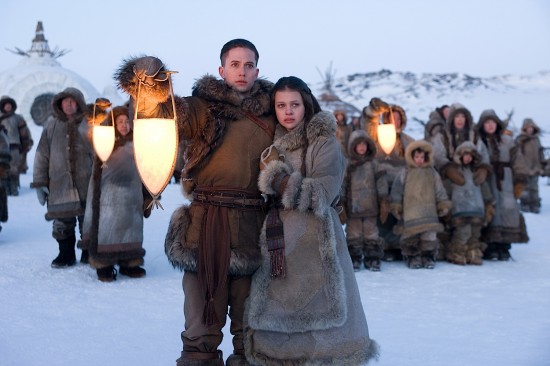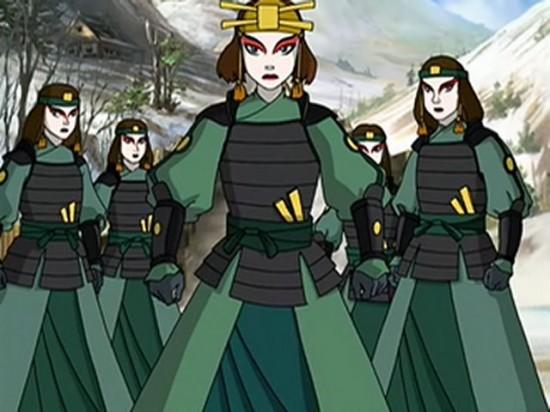Video Interview: M. Night Shyamalan On The Last Airbender
M. Night Shyamalan is a nice guy, which makes the fact that he directed one of the worst films of the year all the more painful. I got a chance to sit down and chat with The Last Airbender director after viewing the film, and it's clear that he's passionate about the material, and that he's very conscious of the racebending controversy. Our discussion touches on him getting used to making a CGI-filled epic film, some material that was cut out, and how he recovered from feeling lost during the production, among other topics.
You can view a video of the interview below (worth watching if only for the moment he realizes something may have been left out of the Blu-ray), download an audio version, or read a transcript of a majority of the discussion. My review of the film, with all the heartache you'd expect from a fan of the series, will be coming soon.
The video begins with Shyamalan responding to a discussion about technology that we started as I was setting up. (I apologize in advance for the shakiness earlier in the video. It gets better after about a minute.)
You can download a slightly longer audio version of the interview here, and it should already be in your feed if you're a Slashfilmcast subscriber. You can subscribe to the Slashfilmcast on iTunes, or on other media programs by using our RSS feed.
Subscribe:
 On how he approaches technology in film making:
On how he approaches technology in film making:
"I had a kind of black and white philosophy before, which was like "I'm not a techy guy, that's the end of the conversation. I'll be the last guy shooting on film, I'll be the last one editing on film" — it was that kind of feeling. I feel like that was maybe too black and white. Maybe the philosophy should be there is old school cinematic storytelling that I really resonate to — a la long takes and really being specific about what you're going for as a filmmaker. Not being general and gathering stuff, and not making the film in the editing room, but making it in your head and trying to get that version.
All of those things I still believe in, and the technology doesn't have to be contrary to that. Like in Airbender, you can use a lot of techniques and still try keep your old school philosophies."
On the difference between shooting this film, versus his previous work:
"You know what was great, and I didn't realize until I got into it deeply, my very bizarre way of making movies — which is very detail oriented, prep-heavy and storyboard-heavy — it's almost like I'm pretending to make animated movies when I make my live action films. It really lent itself well to making a movie of this scale, helped me stay on budget, and be more efficient. It's one thing to not use a shot of you and I in this room room, but it's another to not use a shot of you and I when there's all this CGI going between use — you've just used up $50,000 of your budget for no reason... So I used the prep to kind of make my mistakes, to keep on shooting it in my head, in paper, and in this case previs[ualization].
I put all my anal control freak tendencies into the previs, and I literally made this 30-minute previs that feels like a finished [version of] the end of the movie. And it's poignant to watch these cardboard characters. What that helped me to do is to make the movie many times before we shot the movie."
Was anything cut out for length?
"Not length per se, but emotional distraction... This side character is working so well that it's pulling you away from the main characters and the main story. Especially in a mythology like this, my hope was to bring in other characters and then pay them off in the second or third movies. There's less tolerance for that because the audience loses patience, and you need to make sure the balance is right.
Two things were cut out: Some of the more slapsticky comic stuff didn't work in the movie's tonality. Two, the Kiyoshi Warriors — who I love and had in the movie until the last second, and I just had to come to the truth that they were distracting us... They're like female ninjas, hot ninjas, they're very cool and have these metal fans... So what happens is they came in the movie and disappeared in the final act, and it was very clunky. In over 20 episodes of a [TV] season you don't really notice that, but when it's brought down to two hours you start to feel like "Wait, where did they go?"... If I'm going to introduce such great characters, let me introduce them in the plot and make them vital, I'm going to do that in movie 2. That was a tough one dude.
[I ask if those scenes are going to be on the DVD/Bluray] I decided not to because they're going to be in the next movie, and I didn't want to say I can't use those shots because I put them on the Blu-ray. Maybe some of my planning can now be used in a future planning... Not actual footage, because they're tied to characters here, but the design and introduction of the characters."
On how he chose to shoot the fight scenes:
"Unbreakable was the kind of beginning of this movie for me. The kind of action that would interest me would be choreographed and poetic. When I talk to the stunt coordinators and fight choreographers, I would say that fighting is dialog. It can't just be like "I hit you" and "You hit me"... It has to have struggles and ups and downs, and all those wonderful things that do go on when you fight someone. I had a wonderful time thinking in those things. I studied martial arts, and it was fun to bring all of that to my day jobs."
On his approach to scripting the film:
"The process was delicate. I started with something that was very much like the show. It took me a while to have the courage to start adapting it and making it work as a movie and making it my own... Like, I'm telling this same mythology, how would I tell it?"
Were the original creators involved?
"Oh yah, the whole time. I would show them each track and they were in on storyboarding — they were involved pretty early. As we started to make the film I just went and did my job. In the earlier part they were there a lot, they came to Philly a lot. When we finished the screenplay, they gave it their double-thumbs up."
On regaining his center after feeling lost during the production of the film:
[Based on something he brought up in an interview with 30Ninjas.com] "Movie making with actors and crew and the set, it's a moving amorphous thing that you control or it controls you. If you come on my set, everybody is going off of my vibe. If I want to go quicker, everybody goes quicker. Everyone is kind of oriented to where my head is at, and if I'm frustrated that we're not getting it, everyone gets tense. Everyone gets hyper focused on how to fix it. It just got all too much for me. I wasn't up to the task. It was too many factors going on, too many details. And I lost my way for a week or so, and I was floundering a bit. My crew was just doing the job — no one would know this, I'm just saying that inside my head I kind of lost my way. Maybe I was just low on endurance, this was twice as big as anything I've ever done.
[I mention this is like him doing Lord of the Rings] I remember thinking about what Peter [Jackson] had done on LotR and thinking that was beyond comprehension. To think in those terms for so long — 7 years and 3 movies, I just spend 3 years making this movie... You can be lost in a world for so long."
 On racebending: Is there a value to kids seeing minority races playing lead characters?
On racebending: Is there a value to kids seeing minority races playing lead characters?
"I don't know any Inuits that look like Katara on this planet, I don't know any Asian kids that look like Aang. That's because there's a misunderstanding here — the art form of anime in its genetics has ambiguous features... So everyone sees themselves in that art form, which is what I love... So whoever came to cast and that I felt the ethnic things worked for me — so Dev came and it became Indian and Persian and Mediterannean for the Fire Nation. Shaun Toub and Cliff Curtis worked for those characters as well. Unfortunately, Suki [one of the Kiyoshi Warriors] was Philippino, she's not in the movie, but the Earth Kingdom went that way for me, and it's the broadest nation.
I only had one agenda, which was to work in African Americans in some way. So I'm putting them in one of the cities in the Earth Kingdom, and you'll see that in the second movie. Noah for me, who's basically living Aang, felt a little bit mixed, so I made all the nomads mixed race — as if they were not one race. The monk [Gyatso] was hispanic/african american, a mixture of everything.
For the Water Tribe, I wanted to go Anglo/European/Russian, that sort of feeling. Nicola [Peltz] felt that way to me, and Jackson [Rathbone] looks so much like Sokka to me. Really, the only ones I don't represent in the movie, and it's intentional, is the blond people of the world. So there, I apologize to them. (Laughs)
You know, in the end it's one of the great assets in our movie. I'm pissed that anybody would say anything other than "bravo" when looking at Airbender as a culturally diverse movie. And insinuating that there's a correct Asian, when Avatar is a Sanskrit word — dude I'm an appropriate Asian, so I count okay. To say that when we make Airbender, which is the most culturally diverse tentpole movie of all time, about the most culturally diverse subject of all time, you look at the movie poster that has Noah and Dev back to back and my name on it... It saddens me that there has to be a tiny group of people who have an agenda. It's one of the great assets of the movie."

